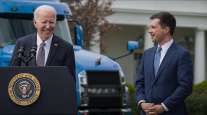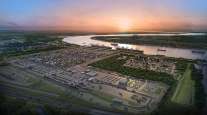Staff Reporter
Platooning Continues to Be Put Under Microscope at Federal Level

[Stay on top of transportation news: Get TTNews in your inbox.]
ALEXANDRIA, Va. — The effects of truck platooning on the nation’s infrastructure continues to be studied, federal officials told the American Society of Civil Engineers’ International Conference on Transportation and Development here.
Derek Constable, a bridge management engineer for the Federal Highway Administration, said the agency has a research project underway to investigate platooning’s impact on structural safety, bridge fatigue limits and design standards.

In our first episode of RoadSigns, Season Four, we ask: What Does the Future Hold for Truck Platooning? Hear a snippet from Cetin Mericli, CEO and Founder of Locomation, above, and get the full program by going to RoadSigns.TTNews.com.
“Connected and autonomous vehicle technology is advancing rapidly and has the potential to significantly change highway transportation infrastructure requirements,” Constable said.
He explained that trucks must comply with the federal bridge formula, which outlines how a vehicle’s weight must be displaced depending on its size and number of axles.
But establishing a blanket load model is difficult, he said, because there are variations in the vehicle configurations that may cross a bridge. He said that capacity limits and weight requirements would depend on a number of factors, including truck weight, spacing and how many trucks are in a platoon.
Truck platooning refers to two or more trucks using vehicle-to-vehicle communication systems to travel in a tight formation. Platooning can involve different levels of automation, from trucks trailing one another at close distances to departing lanes. It automates braking and acceleration, too, although drivers continue to steer manually in both vehicles.

Cammisa
Many companies have experimented with platooning as a means to streamline freight movement and save on fuel costs.
Consultant Michael Cammisa said that platooning can potentially result in 4.5% fuel savings for the lead truck and 10% fuel savings for the following trucks.
In addition to fuel savings and congestion reduction, platooning has the potential to improve safety, said Gene McHale, a team leader within the Federal Highway Administration’s Office of Operations Research and Development. Automated systems don’t run the risk of becoming fatigued or distracted like human drivers.
“Platooning trucks, especially with vehicle-to-vehicle communications, should be able to react much quicker than a human driver,” McHale said.

McHale
FHWA is examining truck platooning through a couple of lenses: One is a study of the human factors associated with platooning, such as issues passenger vehicles face when navigating around trucks. It plans to use a signage lab to test motorist comprehension of various visual indicators and a driver simulator that will task participants with sharing the road with platooning trucks. The other involves conducting a Truck Platooning Early Deployment Assessment to better understand platooning activities in authentic situations.
McHale said one objective is to establish partnerships with state agencies and industry groups. “The goal is to actually operate trucks at an in-service environment where they’re hauling real freight,” McHale said. “This will be a more in-depth look at operational situations.”
FHWA’s previous forays into platooning research include a naturalistic driving study, which examined following behavior for heavy trucks that trailed light vehicles and other trucks, as well as Exploratory Advanced Research projects with the California Department of Transportation and Auburn University.




